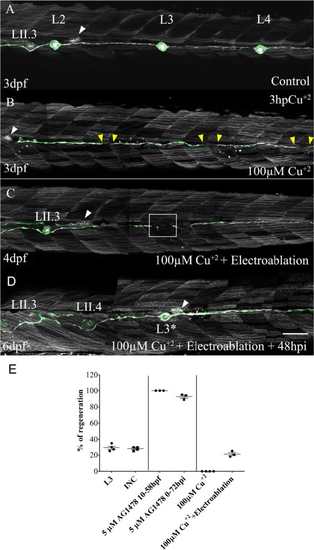Fig. 6
- ID
- ZDB-FIG-171110-40
- Publication
- Sánchez et al., 2016 - Mechanosensory organ regeneration in zebrafish depends on a population of multipotent progenitor cells kept latent by Schwann cells
- Other Figures
- All Figure Page
- Back to All Figure Page
|
Damage to Schwann cells is required for neuromast regeneration. tg(cxcr4b:mCherry;et20:GFP) larvae 3 days post fertilization (dpf) were treated with 100 μM CuSO4 for 2 h to ablate all neuromasts without affecting Schwann cells. a A control (uninjured) larva showing the region between L2 and L4. The secondary primordium (PrimII) is seen migrating (white arrowhead in all images). b Three hours after copper treatment, all neuromasts of the lateral line system had been chemically ablated (gaps demarcated by yellow arrowheads). c At 24 hours post treatment (4 dpf), interneuromastic cells (INCs) had filled the gaps but no neuromast regeneration occurred. At this time, electroablation was carried out at the approximate position where L3 was (white box). d A new L3 neuromast formed only where electroablation took place at 48 hours post injury (hpi; at 6 dpf). Neither intervention (copper treatment or electroablation) impaired the migration of PrimII (white arrowhead) and deposition of secondary neuromasts (LII.3). The asterisk indicates the site of injury. e The graph shows the percentage of injured larvae that regenerated a neuromast after the different treatments: L3 neuromast electroablation (L3; n = 100); electroablation of INCs between the L2 and L3 neuromasts (INC; n = 100); L3 neuromast electroablation in larvae treated with 5 μM of AG1478 from 10 hpf until 58 hpf (5 μM AG1478 10–58 hpf; n = 75); L3 electroablation in larvae treated with 5 μM of AG1478 from 0 hpi until 72 hpi (5 μM AG1478 0–72 hpi; n = 75); 100 μM copper treatment (100 μM CuSO4, n = 100); or copper treatment combined with electroablation of L3 (100 μM CuSO4 + Electroablation; n = 60). Scale bar a–d: 100 μm. Further details on replicates are provided in “Quantifications and statistical analysis” in the “Methods” section |
| Fish: | |
|---|---|
| Conditions: | |
| Observed In: | |
| Stage: | Protruding-mouth |

